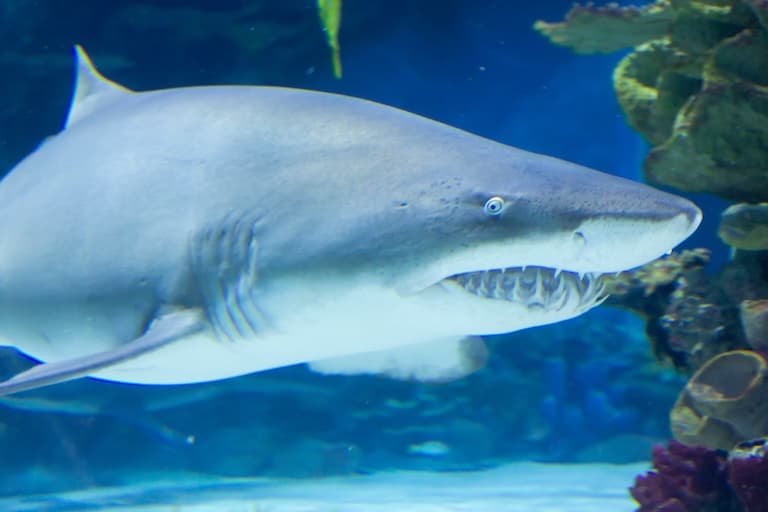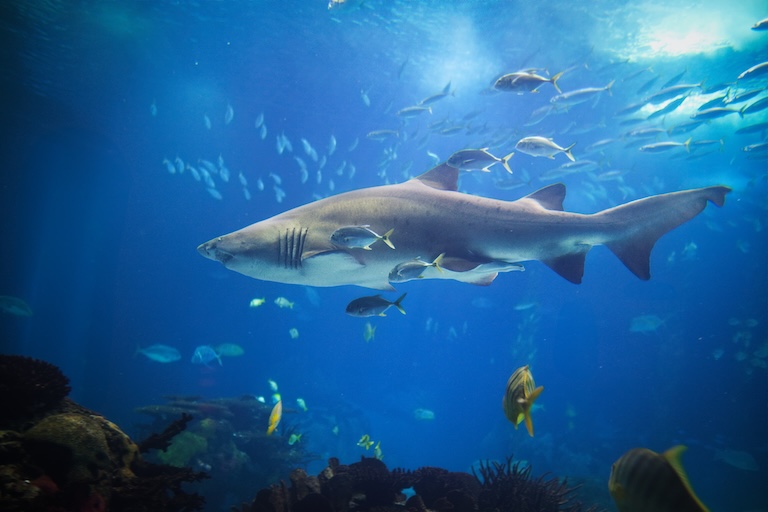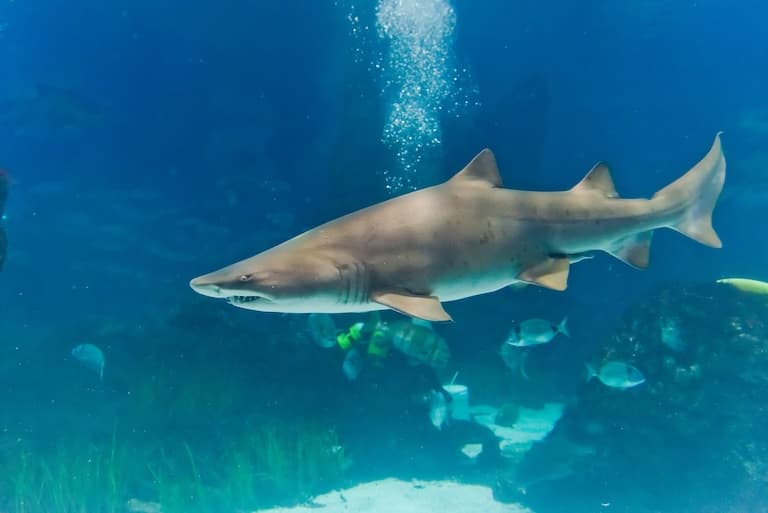Sand Tiger Shark Profile
Anyone interested in sharks knows there’s a huge divide between their fearsome appearance or media representation, and their relatively docile and puppy-like behaviour in reality (with a handful of notable exceptions). And perhaps the shark easiest to misrepresent in this way is the sand tiger shark.
Everything from its fearsome name to its razor-wire mouth and imposing size give it the air of a far more aggressive and ferocious animal. Sadly, this placid Lamniform is all-but extinct in the wild and needs far better PR.

Sand Tiger Shark Facts Overview
| Habitat: | Tropical, subtropical and temperate coastal waters |
| Location: | Worldwide |
| Lifespan: | 35 years in the wild, 16 in captivity |
| Size: | Up to 6m long |
| Weight: | Up to around 300kg in extreme cases (average 110kg) |
| Colour: | Grey/blue, sometimes greeny-yellow |
| Diet: | Generalist predators; mostly bony fish, also skates, rays, crustaceans |
| Predators: | Larger sharks |
| Top Speed: | Around 20km/h (12 mph) |
| No. of Species: | 1 |
| Conservation Status: | Critically Endangered |
Sand Tiger sharks are cursed with a dozen names, and none of them are flattering. Yet, as long as you’re not on the menu, these are peaceful animals who enjoy a slow pace of life. Still, they’re large sharks, and when threatened by divers can give a nasty nip. But ultimately, we’re doing infinitely more harm to them than they are to us.
Interesting Sand Tiger Shark Facts
1. They have a lot of names
Common names in sharks get a bit confusing. This shark is a member of the Sand shark family, Odontaspididae.
Within this family are three species, the smalltooth sand tiger, the bigeye sand tiger and this friendly fellow, the sand tiger.
That’s easy enough, but common names for the sand tiger include the Grey Nurse shark, (it’s not a nurse shark), the Dogfish shark (it’s not a dogfish) and the blue nurse sand tiger, which holds the record for the number of sharks it’s not.
It should go without saying that this isn’t a tiger shark, either.
One other common name is the ragged-tooth shark, which isn’t taken by any other shark and does a decent job of describing the animal and is the only name that doesn’t get something wrong.
These are fairly large sharks, in the same order as the Great White and Goblin shark.

2. They have fatty livers
These sharks, like all sharks, move around without a swim bladder. Swim bladders are used by bony fishes as a buoyancy aid; they’re essentially air balloons that can be regulated to increase and decrease depth without putting a lot of energy into it.
Incidentally, one long-standing hypothesis states that you have a pair of modified swim bladders in your chest, all thanks to your 375-million-year-old grandparents who used them to absorb oxygen from the atmosphere when they left the water (another suggests that fish actually had lungs before swim bladders were invented, but all of this is beside the point because sharks have neither).
This means they have to use other methods of buoyancy, and in all cases, this means an oily liver that lowers the average density of the fish and allows it to take a break without sinking to the ocean floor.
The Sand tiger shark’s liver has been a source of tremendous destruction for the species, which is hunted relentlessly for the oils it contains. They’re also hunted for their fins. Needless to say, the shark needs both of these to stay afloat.
But these livers aren’t the only buoyancy at its disposal. 1
3. They fart
In settings where a fat liver isn’t enough, these sharks have been witnessed swimming to the surface to take a gulp of air. Swallowing this air essentially allows their digestive system to function as a swim bladder, but of course, what goes in must come out.
Sand tiger sharks are one of the few species known to fart. 2
4. They’re migratory
This species, like many mackerel sharks, travels fairly long distances. Their annual migrations can take them over 3000km from the cold waters where they give birth, to the warmer waters they prefer to hunt in and back again.
Only adults take part in these migrations, it’s thought that the juveniles mature in deeper waters until they’re ready, returning to their Summer locations routinely until the time they’re old enough to migrate. 3
5. They’re not typically aggressive
Now we’re getting into just why these sharks are so unfairly judged. Sand tigers spend a lot of time together during the summer, in groups with all generations present. When the adults go off to migrate, they split up but tracked individuals have been seen to reunite with their friends time and time again.
This is a good sign that they’re preferentially sociable animals, and this is a species known to divers to be docile and relatively polite.
This also makes them popular in aquariums, as they can be maintained without incident. Still, this is a large shark with a lot of teeth, and as such, they have been known to nibble. 4
6. They can be a bit bitey
This species is not regarded as aggressive at all, but there have been incidents of bites occurring. In July 2023, a spate of shark bites in New York brought the two-year total of shark bites for the state to 13 – more than was reported in the previous 175 years.
All these attacks resulted in minor wounds and no deaths. They were thought to have come from sand tigers, brought closer to shore following their prey into warming waters.
Of all the recent migrants into our favourite swimming locations, this is not one to be afraid of. Sand tigers have never killed a person, and there are far more scary jellyfish and parasitic diseases to worry about in the coming years of climate change. 5
7. They’re slow growing
This species reproduces very slowly and grows even slower still. While they’re born at a respectable one-meter long, they only grow an extra 30cm in the first year, and then slow down to around 2.5cm a year.
Pregnancies are thought to only occur every second year and to make things even slower, only two pups are born at a time.
This is one of the key factors that make the species vulnerable to overfishing.
8. They eat one another before they’re born
The reason you only get two sharks per birth is not so much because of a low number of fertilised eggs, but because of the highly cannibalistic nature of the embryos.
This is the one area of shark biology that actually aligns with the scary monster trope. Intrauterine cannibalism involves the largest and strongest embryo feasting on its unborn brothers and sisters.
It’s actually quite a clever way of isolating and facilitating the fittest individual early on, and the Sand tiger was the first to be discovered employing this reproductive strategy. While still fairly rarely seen, there are other species now known to do the same. 6

9. There are so few left
With all the overfishing, sibling munching and environmental destruction working against this slow-breeding fish, it’s hardly surprising that they’re in trouble.
Overfishing is by far the worst threat, but coastal development and pollution are reducing hunting grounds too.
While the dearth of unified terminology for this shark is easy to laugh at, it’s also a problem when it comes to record-keeping. So many confusing common names make fishery data hard to trust, and this makes tracking their numbers complicated.
As of 2020, the species is considered critically endangered, with a severely fragmented population in decline.
Sand Tiger Shark Fact-File Summary
Scientific Classification
| Kingdom: | Animalia |
| Phylum: | Chordata |
| Class: | Chondrichthyes |
| Order: | Lamniformes |
| Family: | Odontaspididae |
| Genus: | Carcharias |
| Species: | taurus |
Fact Sources & References
- “Sand Tiger Shark”, Academic Accelerator.
- “How Do Sharks Fart? The Surprising Science”, Animal Pickings.
- M. L. Dicken (2006), “Spatial and seasonal distribution patterns of juvenile and adult raggedtooth sharks (Carcharias taurus) tagged off the east coast of South Africa”, CSIRO Publishing.
- “Carcharias taurus”, Animal Diversity Web.
- Steven Branstetter (1994), “Age and Growth Estimates for the Sand Tiger in the Northwestern Atlantic Ocean”, American Fisheries Society.
- “Intrauterine Cannibalism in Sharks”, Elasmo Research.
